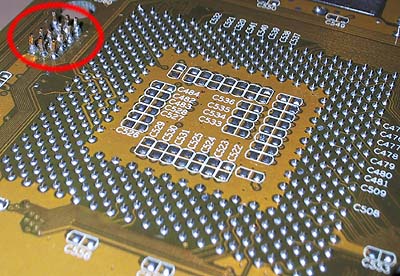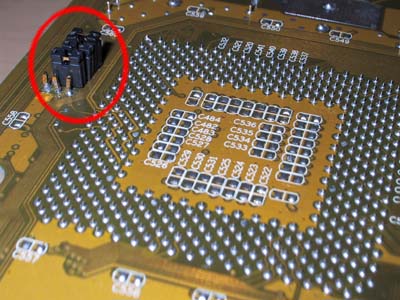AMD Thunderbird/Duron Investigation & Overclocking Discussion
by Anand Lal Shimpi on July 12, 2000 7:09 PM EST- Posted in
- CPUs
We actually have two AZ-11 boards, the first was a pre-release engineering sample we requested ahead of time in order to include it in our original Socket-A Motherboard Preview. On this board, as you can see from the picture below, there was an unusual set of jumpers that were physically hacked off of the motherboard after production.

Looking at the bottom of the board, we also noticed that the jumpers were obviously placed on the board after the fact since the leads of this particular jumper block stuck out much further than the rest of the leads on the back of the board.
At the time, we thought nothing of it, since AMD had already told us that the CPUs were completely multiplier locked, although we did think it was odd that FIC would go to the trouble to saw off that block of jumpers before sending us the motherboard.
After reading about Tom’s Hardware Guide’s overclocking success with the ASUS A7V (which we will be reviewing shortly), we decided that maybe it was worth looking into those mysterious jumpers on the AZ-11.
We noticed that the four pins on the AZ-11 could potentially correspond to the four Frequency ID pins Tom described in his article. By assuming that the position 1-2 on our 4 x 3 jumper block corresponded to the Athlon/Duron’s FID setting of 1 and assuming that the remaining 2-3 setting on our jumper block corresponded to an FID setting of 0, we went to work.
The AZ-11’s jumpers were labeled, from top to bottom: OVERRIDE2, OVERRIDE1, OVERRIDE 4, OVERRIDE 3. These four jumpers, each with three pins, conveniently correspond to the four FID pins, making OVERRIDE1 the jumper that controls FID0, OVERRIDE2 the jumper that controls FID1, OVERRIDE3 the jumper that controls FID2 and OVERRIDE4 the jumper that controls FID3.

Since the top of the pins were cut off we took advantage of the fact that the leads were so long and simply placed jumpers on the bottom of the board instead of on the top where they would normally go.
Lo and behold, the AZ-11 was able to adjust the clock multiplier of all of our CPUs using these jumpers. Unfortunately, this pre-release AZ-11 board wasn’t as stable as we would liked it to be in order for us to run a full suite of benchmarks at all available clock speeds…












0 Comments
View All Comments